
Preservation Self-Assessment Program
Wire Media
Unique Content
If what you are assessing is a commercially produced item, more than likely it is not "unique." It may be unique to your archive but, at some point, it was mass produced. Truly unique items often require priority in preservation because they may be the sole remaining document of this material.
First Generation / Master / Original Items
When we talk about "generations" in audiovisual preservation, we're talking about "copies." If something is a second-generation item, it means that it has been copied from the original, or "master." (We should note that sometimes people use the term "master copy," which can be confusing. A master copy is a master.)
The original audiovisual item is the most valuable iteration of the item that you can have, because it should have the best audio and video quality possible when compared to its copies. (This assumes, of course, that the original has been well preserved and is in good shape.) Another reason for giving priority to the original is that it may be the only iteration there is of the item. This means that any damage that occurs to the original could mean that information is lost forever. Even if you have a copy, damage to the master means that you must resort to using copies that may have inferior picture and/or sound.
Following best practice, you should use the master as little as possible and store it in the best conditions possible. Many institutions use their master once to make a "secondary master." This secondary master is then used to make copies for access. Ideally, you should almost never have to return to the master so that it can stay in the best possible storage conditions in perpetuity. If the item you are assessing is a master, then it will be higher in priority for reformatting and preservation than those items which are copies.
Risks of Handling/Playback
Playback and handling are the leading causes of damage to audiovisual items. A film, for example, is most likely to be damaged being fed into or coming off of a projector. Any playback machine, no matter how well maintained, can cause damage to an audiovisual item. That said, it is still best to maintain your playback equipment alongside your audiovisual items. Regular service and cleaning is critical to helping minimize the risks of playback for your materials. An item may sometimes only have one play left before it is permanently damaged, rendering it unusable. If an item must be played back, an operator skilled in handling the playback equipment and at identifying problems with the media prior to playback should be the only person allowed to play the material in question. Allowing media to be handled and played back by untrained staff or patrons is a danger to the material.
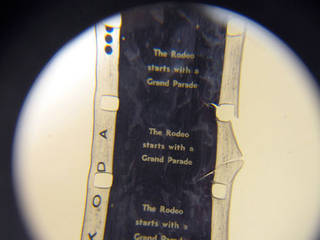
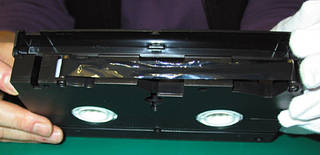
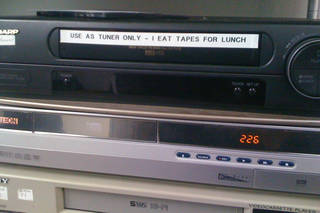
Playback Equipment
One of the great challenges of audiovisual preservation is the fact that AV materials require playback machines in order to "decode" the information stored on the materials. This applies to all audiovisual formats. Of course, a further complication is that the playback machine must be appropriate to the format of the AV material. When we consider how many hundreds of AV formats there are, we see that this is a large challenge indeed. The playback machine must also be well-maintained because it can damage the materials fed into it if the machine is in poor repair.
It is important to look at your collection and consider what formats are most valuable to your institution, what formats are accessed the most by your users, and what format you have the most of. These will be the materials that you should have playback equipment for, if at all possible. This can be challenging, but there are avenues you can explore. Local television and radio stations, colleges and universities (particularly those with film, art, communications, or journalism departments), and audio recording studios often have older equipment that they no longer need. As a result, these are excellent places to establish relationships with as you may be able to procure equipment at very reasonable prices. However, keep in mind that universities and colleges often have considerable red tape when selling or donating their equipment, so you should be prepared to invest some time and effort when working with them.
Remember: never put any collections materials into a playback machine without first testing that machine. Have a "dummy" item that you can test a piece of equipment with. For example, you can designate a VHS tape as your dummy tape and use it to test your recently procured and/or serviced VCR. Ideally, this tape should neither be an item that is a part of your collection nor have any value so that it will make no difference if you damage the item.
We do not recommend that you service a piece of playback equipment yourself because of the potential for damage to both the equipment and AV materials. We recommend that you find and establish a relationship with a local repair service. Maintaining your playback equipment should be at least as important as maintaining your collections.
If you do not have (and cannot acquire) playback equipment, it does not mean that the AV materials are without value. In fact, it may be an indicator of higher preservation priority if the playback equipment is obsolete or unavailable to you at your archives. These materials can be especially vulnerable. Film duplication vendors will most likely have the equipment and can transfer the film to a format accessible to your archives.
Remember, if you have materials with no way to play them back, these items will have diminished accessibility. They can end up costing you time, effort, and money when you have to send them out to be transferred to a format for which your institution does have playback equipment. If you plan to digitize your materials, you will have to have well-functioning playback equipment for each format you decide to digitize.
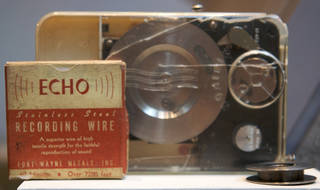
Orientation in Storage
There does not seem to be a professional consensus for storing wire recordings in either a horizontal or vertical position. We recommend securing the wire around the reel so that it does not become loose and tangle; you can use either unrecorded stainless steel wire or plastic as leader. Some professionals recommend storing wires in the "tails out" (i.e. with the end of the recording at the top of the reel rather than close to the hub of the reel) to lessen the effects of print-through. However, this may not be practical due to the scarcity of wire recording equipment and due to the risk involved in mounting the wire on the playback equipment.
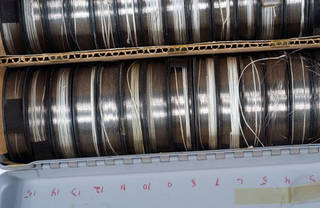
Wire - Appropriate Container
Although most wire recordings were composed of stainless steel recording-grade wire, some early wire recordings were composed of less rust-resistant material. Removing the wire recordings from their original cardboard containers, which are subject to mold infestation and do not protect the recordings from moisture, and storing the recordings in a protective plastic container are both recommended.
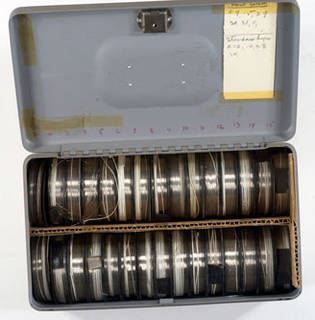
Labeling
Correct labeling on a container can offer important clues about what is recorded on the wire. If you are replacing a container that has labeling information, it is important to transfer this information to the new container or label. Original container labels should be regarded with caution, however, as containers are frequently reused or switched by accident. If possible, verify the validity of the container label. Your recording may have a matrix number imprinted on it, which can be used to reference a catalog entry that can verify the content on the recording. However since wire recordings were often not commercially produced, you may have to go on good faith that the container label properly identifies the intellectual content of the wire because there probably will not be additional resources to consult.
Wire - Physical Damage
One of the most common issues that arises when handling wire recordings is tangled wire. The wire is extremely thin (approx .004 inches thick). It can easily wrap around itself, become tangled, and possibly break. This problem is an annoyance but can be resolved without too much trouble—the wire just needs to be untangled and rewound onto the reel. Breaks in the wire can be repaired by knotting the two ends of the wire together. Since wire travels at a high transport speed, the knot will be a minor sonic disturbance during playback. However, wire in poor shape (e.g. many breaks, crimps, and tangles) may be indicative of prior neglect. Retrieving recorded signal from wire in poor shape may prove more difficult than in other cases.

Mold / Pest Damage
Mold
MOLD CAN BE TOXIC. Proceed with caution when examining items for mold. Do not handle moldy materials longer than necessary. If you find a moldy item, immediately seal it and its container in a sealable plastic bag until conservation action can be taken.
Wire media itself does not mold; however, the cardboard and other paper-based containers housing wire media can. While many wire recordings are on metal spools, the outer enclosures of wire can be paper-based and will thus be more susceptible to moisture-wicking and mold growth--both conditions which are also favorable for rust formation. Containers can speak volumes on the storage history of your recording. High humidity and temperature in your storage area can foster the growth of mold on the associated containers.
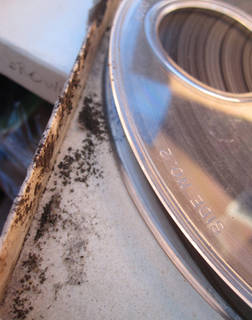
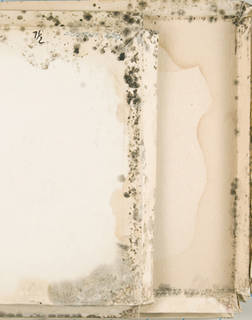
Pests
Pests like insects and rodents tend to like paper and textile materials more than audiovisual materials. That said, pests can still do damage to your AV collections. When assessing the exposure of your collections to pests, it is necessary to look not just at the materials themselves and their containers but also to look at the rest of the environment. Insects and rodents tend to leave droppings in areas they inhabit. Insects tend to leave behind a substance called frass, which is the undigested fibers from paper. If you see droppings and/or frass in your storage area, it is a strong sign that your materials are being exposed to pests. Small, irregular holes on paper-based containers (e.g. sleeves for grooved-disc audio recordings) are also a sign that pests have attacked your materials.
Some tips for reducing your materials' exposure to pests are to refrain from eating anywhere near your collections materials. Crumbs draw rodents and insects, so keep food far from your collections. Another tip is to be careful opening donated materials when you receive them. Pests can hitch rides into your facility on these materials, so having a good, clean staging area where you can inspect donated items for pest-related evidence can help you reduce your storage environments' exposure to pests.
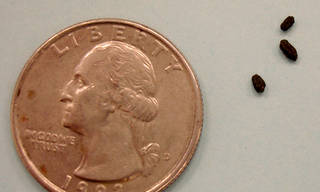
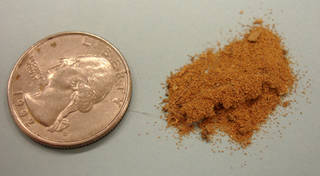
Wire - Rust
Although wire recordings are generally composed of recording-grade stainless steel, some recordings prior to World War II were made on steel wire, which is prone to rust. Rust can weaken the already thin wire and cause it to break during handling or playback. It can even impede signal retrieval. However, occurrences of rust on wire are typically rare.
Playback Quality
It is often difficult to truly assess an item's condition without playing it back. It is entirely possible to have an item that, to the eye, appears to be in good condition, but when played has very bad sound quality. Playback, however, carries with it the risk that your item could be irrevocably damaged and/or could cause damage to the playback machine. For this reason, we do not recommend playback as a means of assessment. However, if you do play an item and find that the sound quality is poor, it likely means the item is in need of reformatting. If this item has been played back recently, there may be notes indicating the playback quality.
Documentation
Having additional documentation about your item can help inform your future preservation decisions. A strictly visual inspection of an item will not provide all the clues about the item's sound quality. If you have any past documentation about playback or wire quality, this information can be extremely useful in assessing the wire without having to subject it to playback risks. Additionally, documentation may provide evidence of past preservation measures taken on the content or item. You should always document any preservation measures that you take on your materials. This provides evidence to future preservationists and researchers about the path that the content/object has traveled.
Your documentation should generally NOT be stored with the item. You should store your documentation (e.g. notes written on paper) in a separate physical location. Paper has numerous conservation issues and can be more damaging than helpful in most cases, but not necessarily for wire recordings. Just the same, if you track your items via electronic means, you may be able to note preservation history in your electronic tracking system and should consider consulting resources on responsible metadata practices.